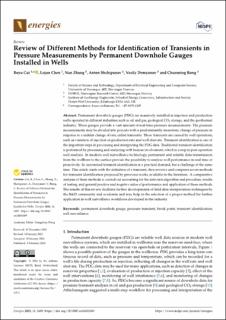| dc.contributor.author | Cui, Boyu | |
| dc.contributor.author | Chen, Lejun | |
| dc.contributor.author | Zhang, Nan | |
| dc.contributor.author | Shchipanov, Anton | |
| dc.contributor.author | Demyanov, Vasily | |
| dc.contributor.author | Rong, Chunming | |
| dc.date.accessioned | 2024-01-02T11:51:29Z | |
| dc.date.available | 2024-01-02T11:51:29Z | |
| dc.date.created | 2023-06-07T09:46:35Z | |
| dc.date.issued | 2023 | |
| dc.identifier.citation | Cui, B.; Chen, L.; Zhang, N.; Shchipanov, A.; Demyanov, V.; Rong, C. (2023) Review of Different Methods for Identification of Transients in Pressure Measurements by Permanent Downhole Gauges Installed in Wells. Energies, 16(4), 1698 | en_US |
| dc.identifier.issn | 1996-1073 | |
| dc.identifier.uri | https://hdl.handle.net/11250/3109306 | |
| dc.description.abstract | Permanent downhole gauges (PDG) are massively installed in injection and production wells operated in different industries such as oil and gas, geological CO2 storage, and the geothermal industry. These gauges provide a vast amount of real-time pressure measurements. The pressure measurements may be divided into periods with a predominantly monotonic change of pressure in response to a sudden change of rate, called transients. These transients are caused by well operations, such as variation of injection or production rate and well shut-ins. Transient identification is one of the important steps in processing and interpreting the PDG data. Traditional transient identification is performed by processing and analyzing with human involvement, which is a step in post-operation well analysis. In modern well surveillance technology, permanent and reliable data transmission from the wellbore to the surface provide the possibility to analyze well performance in real time or proactively. So automated transient identification is a practical demand, but a challenge at the same time. This article starts with the definition of a transient, then reviews and compares seven methods for transient identification proposed by previous works available in the literature. A comparative analysis of these methods is carried out accounting for the detection algorithm and procedure, results of testing, and general positive and negative sides of performance and application of these methods. The results of this review facilitate further developments of field data interpretation techniques by the R&D community and academia and may help in the selection of a proper method for further application in well surveillance workflows developed in the industry. | en_US |
| dc.language.iso | eng | en_US |
| dc.publisher | MDPI | en_US |
| dc.rights | Navngivelse 4.0 Internasjonal | * |
| dc.rights.uri | http://creativecommons.org/licenses/by/4.0/deed.no | * |
| dc.subject | pressure transient analysis | en_US |
| dc.title | Review of Different Methods for Identification of Transients in Pressure Measurements by Permanent Downhole Gauges Installed in Wells | en_US |
| dc.title.alternative | Review of Different Methods for Identification of Transients in Pressure Measurements by Permanent Downhole Gauges Installed in Wells | en_US |
| dc.type | Peer reviewed | en_US |
| dc.type | Journal article | en_US |
| dc.description.version | publishedVersion | en_US |
| dc.rights.holder | © by the author(s) 2023 | en_US |
| dc.subject.nsi | VDP::Andre berg- og petroleumsfag: 519 | en_US |
| dc.subject.nsi | VDP::Other subjects within rock and petroleum sciences: 519 | en_US |
| dc.source.pagenumber | 0 | en_US |
| dc.source.volume | 16 | en_US |
| dc.source.journal | Energies | en_US |
| dc.source.issue | 4 | en_US |
| dc.identifier.doi | 10.3390/en16041689 | |
| dc.identifier.cristin | 2152478 | |
| dc.source.articlenumber | 1689 | en_US |
| cristin.ispublished | true | |
| cristin.fulltext | original | |
| cristin.qualitycode | 1 | |

